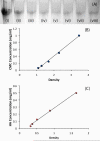Cytokine binding by polysaccharide-antibody conjugates
- PMID: 20726535
- PMCID: PMC3008761
- DOI: 10.1021/mp100150z
Cytokine binding by polysaccharide-antibody conjugates
Abstract
Cytokine-neutralizing antibodies are used in treating a broad range of inflammatory conditions. We demonstrate that monoclonal antibodies against interleukin-1β and tumor necrosis factor-α were still active when conjugated to high molecular weight polysaccharides. These polysaccharides are hydrophilic, but their size makes them unable to circulate in the bloodstream when delivered to tissues, opening up the possibility of localized treatment of inflammatory conditions. To explore this new class of protein-polysaccharide conjugates, we covalently modified interleukin-1β and tumor necrosis factor-α monoclonal antibodies with high molecular weight hyaluronic acid and carboxymethylcellulose. Rigorous purification using dialysis with a 300 kDa-cutoff membrane removed unconjugated monoclonal antibodies. We characterized the composition of the constructs and demonstrated using molecular binding affinity measurements and cell assays that the conjugates were capable of binding proinflammatory cytokines. The binding affinities of both the unconjugated antibodies for their cytokines were measured to be approximately 120 pM. While all conjugates had pM-level binding constants, they ranged from 40 pM for the hyaluronic acid-(anti-interleukin-1β) conjugate to 412 pM for the carboxymethylcellulose-(anti-interleukin-1β) conjugate. Interestingly, the dissociation time constants varied more than the association time constants, suggesting that conjugation to a high molecular weight polysaccharide did not interfere with the formation of the antibody-cytokine complex but could stabilize or destabilize it once formed. Conjugation of cytokine-neutralizing antibodies to high molecular weight polymers represents a novel method of delivering anticytokine therapeutics that may avoid many of the complications associated with systemic delivery.
Figures







Similar articles
-
Polymer-conjugated inhibitors of tumor necrosis factor-α for local control of inflammation.Biomatter. 2013 Jul-Sep;3(3):e25597. doi: 10.4161/biom.25597. Epub 2013 Jul 10. Biomatter. 2013. PMID: 23903893 Free PMC article. Review.
-
Biological activities of cytokine-neutralizing hyaluronic acid-antibody conjugates.Wound Repair Regen. 2010 May-Jun;18(3):302-10. doi: 10.1111/j.1524-475X.2010.00591.x. Epub 2010 Apr 15. Wound Repair Regen. 2010. PMID: 20412551
-
Tip-Loaded Dissolvable Microneedle Arrays Effectively Deliver Polymer-Conjugated Antibody Inhibitors of Tumor-Necrosis-Factor-Alpha Into Human Skin.J Pharm Sci. 2016 Nov;105(11):3453-3457. doi: 10.1016/j.xphs.2016.07.008. Epub 2016 Aug 17. J Pharm Sci. 2016. PMID: 27544434 Free PMC article.
-
Design principles for cytokine-neutralizing gels: Cross-linking effects.Acta Biomater. 2010 Dec;6(12):4708-15. doi: 10.1016/j.actbio.2010.06.029. Epub 2010 Jun 30. Acta Biomater. 2010. PMID: 20601239 Free PMC article.
-
Anticytokine Immune Therapy and Atherothrombotic Cardiovascular Risk.Arterioscler Thromb Vasc Biol. 2019 Aug;39(8):1510-1519. doi: 10.1161/ATVBAHA.119.311998. Epub 2019 Jul 11. Arterioscler Thromb Vasc Biol. 2019. PMID: 31294625 Free PMC article. Review.
Cited by
-
Therapeutic intradermal delivery of tumor necrosis factor-alpha antibodies using tip-loaded dissolvable microneedle arrays.Acta Biomater. 2015 Sep;24:96-105. doi: 10.1016/j.actbio.2015.05.036. Epub 2015 Jun 18. Acta Biomater. 2015. PMID: 26093066 Free PMC article.
-
Advances in hydrogels for capturing and neutralizing inflammatory cytokines.J Tissue Eng. 2025 Jun 25;16:20417314251342175. doi: 10.1177/20417314251342175. eCollection 2025 Jan-Dec. J Tissue Eng. 2025. PMID: 40575355 Free PMC article. Review.
-
Polymer-conjugated inhibitors of tumor necrosis factor-α for local control of inflammation.Biomatter. 2013 Jul-Sep;3(3):e25597. doi: 10.4161/biom.25597. Epub 2013 Jul 10. Biomatter. 2013. PMID: 23903893 Free PMC article. Review.
-
Capturing Cytokines with Advanced Materials: A Potential Strategy to Tackle COVID-19 Cytokine Storm.Adv Mater. 2021 May;33(20):e2100012. doi: 10.1002/adma.202100012. Epub 2021 Apr 10. Adv Mater. 2021. PMID: 33837596 Free PMC article. Review.
-
Inflammation-Modulating Hydrogels for Osteoarthritis Cartilage Tissue Engineering.Cells. 2020 Feb 12;9(2):419. doi: 10.3390/cells9020419. Cells. 2020. PMID: 32059502 Free PMC article. Review.
References
-
- Thomson AW, Lotze MT. The Cytokine Handbook. 4th ed. Academic Press; London: 2003. p. 1536.
-
- Brekke OH, Sandlie I. Therapeutic antibodies for human diseases at the dawn of the twenty-first century. Nat Rev Drug Discov. 2003;2(1):52–62. - PubMed
-
- Bongartz T, Sutton AJ, Sweeting MJ, Buchan I, Matteson EL, Montori V. Anti-TNF antibody therapy in rheumatoid arthritis and the risk of serious infections and malignancies: systematic review and meta-analysis of rare harmful effects in randomized controlled trials. Jama. 2006;295(19):2275–85. - PubMed
-
- Veronese FM, Pasut G. PEGylation, successful approach to drug delivery. Drug Discov Today. 2005;10(21):1451–8. - PubMed
-
- Kubetzko S, Sarkar CA, Pluckthun A. Protein PEGylation decreases observed target association rates via a dual blocking mechanism. Molecular Pharmacology. 2005;68(5):1439–1454. - PubMed
Publication types
MeSH terms
Substances
Grants and funding
LinkOut - more resources
Full Text Sources
Other Literature Sources

